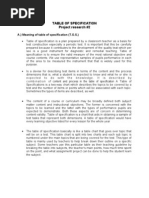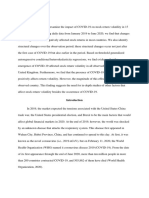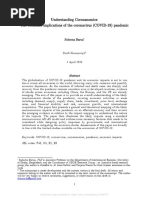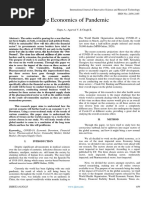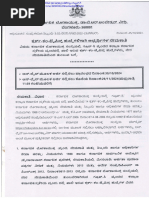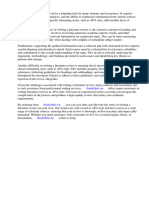Analysis of The Effect of COVID-19 On The Stock Market and Potential Investing Strategies
Analysis of The Effect of COVID-19 On The Stock Market and Potential Investing Strategies
Uploaded by
szaszaszCopyright:
Available Formats
Analysis of The Effect of COVID-19 On The Stock Market and Potential Investing Strategies
Analysis of The Effect of COVID-19 On The Stock Market and Potential Investing Strategies
Uploaded by
szaszaszOriginal Title
Copyright
Available Formats
Share this document
Did you find this document useful?
Is this content inappropriate?
Copyright:
Available Formats
Analysis of The Effect of COVID-19 On The Stock Market and Potential Investing Strategies
Analysis of The Effect of COVID-19 On The Stock Market and Potential Investing Strategies
Uploaded by
szaszaszCopyright:
Available Formats
Received <day> <Month>, <year>; Revised <day> <Month>, <year>; Accepted: 00 Month 0000
DOI: xxx/xxxx
ARTICLE
Analysis of the Effect of COVID-19 On the Stock Market and
Potential Investing Strategies
Heather Yan | Andy Tu | Logan Stuart | Qingquan Zhang
Gies School of Business, University of
Illinois Urbana-Champaign, Illinois,United Abstract
State
In this paper, we analyze the potential effects that the coronavirus, “COVID-19”, will
have on the stock market and then we propose possible ways that an individual could
profit off a market affected by a global viral outbreak. We look at past outbreaks and
come to the conclusion that often markets will react adversely to these such incidents
in the short run but that in the long run, markets eventually correct themselves and
increase. In order to profit off of such a market, we propose shorting industries that
will be immediately affected by the virus in the short run and then eventually buying
back into those industries after their price has dropped significantly. Specifically, we
look at the travel industry, technology industry, entertainment industry, and gold as
potential areas where great profit can be made.
1 INTRODUCTION
The Covid-19 outbreak is an international pandemic that has taken the world by storm. As of May 1, there are approximately
3.4 million reported cases of Covid-19 around the world with approximately 240,000 reported deaths 1 . When a new virus
outbreak occurs, no one fully knows what the long term effect of the virus will be. There could be long lasting effects on both the
health of the public and on the stock market. If we look back historically to the year 2003 when there was the SARS outbreak,
another type of coronavirus, in retrospect, we know that the SARS outbreak did not affect nearly as many people, with only
8096 reported cases and 774 deaths 2 . However, the actual direct effects of a pandemic aren’t always what moves the market.
The stock market often moves with speculation. Between January 2013 and the middle of March 2013, the time period that the
SARS outbreak was occuring, the Dow Jones Index fell roughly 15% from peak to trough due to fear and uncertainty surrounding
the virus. This may seem bad but by the end of the year, the Dow Jones Index was up roughly 21% YTD or about 39% from
its lowest point of the year! In fact, it only took about 3 months from when the Dow Jones hit its bottom to get back up to its
previous peak (Exhibit 1). For a relatively tame outbreak like SARS, there was a short run market shock that decreased the value
of stocks but in the long run, stocks returned to their previous levels and even reached new highs.
SARS is the same type of virus as COVID-19 but the reaction to the viruses couldn’t be any more different. COVID-19
has caused locations to completely shut down, forcing residents to stay inside and either stop working or work from home. Travel
bans have been instituted en masse completely preventing both people and goods from moving around. Currently, it isn’t fully
known what sort of long term effects that the virus may have on the economy as a whole. Because of this, it might be better to
look further into the past at the Spanish Flu as a comparable pandemic. The Spanish Flu was the world’s deadliest pandemic of
the 20th century. It’s estimated that at least one third of the world’s population had the disease and that over 50 million people
1 Worldometer, 2020
2 World Health Organization, 2003
Electronic copy available at: https://ssrn.com/abstract=3563380
2
perished because of it 3 . One would think that such a pandemic disease would have huge negative effects on the stock market
but that wasn’t the case. Outbreak of the Spanish flu occurred in early 1918 with the worst of the pandemic being in the fall of
1918. If we actually look at stock returns from that period though, we will generally see that the market was not that greatly
affected. From the beginning of 1918 to the end of 1918, the stock market was generally trending upward with a few hiccups.
By the end of the year, the Dow Jones ended 7% higher than at the start. Furthermore, we actually see that in 1919, the market
actually rallied almost 50% until it eventually came crashing back down in 1920(Exhibit 2)4 . Of course, at that same time period
world war 2 had just ended which undeniably fueled a market rally. Because of this, the Spanish flu is not an apples to apples
comparison for the COVID-19 pandemic in terms of stock market effects but there is one important insight we can glean from
looking at the Spanish flu; Even with market shocks, stocks do well in the long run.
If we conclude that the market will act similarly to how it has in the past, then we can assume that there will be short
term stock decreases but increases in the long term. This means there is great potential to buy stocks from strong companies at
a discounted price! We propose that in order to maximize profits from the virus, in the short run, we short various industries but
in the long run, we should buy stocks that have dipped and hold them. In particular, we think that the travel industry would be
hit the hardest by a pandemic and so shorting the industry in general would lead to the most guaranteed profit.
2 ANALYSIS AND STRATEGY BY INDUSTRY
2.1 Travel-related industry
Due to the outbreak of Covid-19, various travel bans and stay at home orders have been instated. Usually, March is the
time where most universities have spring breaks and students decide to travel. However, due to travel bans and general concern
surrounding the virus, many people are either unable to travel or are electing to not travel. Due to the large amount of travel
cancellations and general apprehension about traveling, the travel-related industry will be affected deeply.
Online travel agencies such as Booking and Expedia are the first to experience these effects. These online travel agencies
earn money from every reservation they sell. When people cancel their reservations or stop traveling, these agencies lose revenue.
Similarly, hotel companies also suffer the same fate since there will be a lot of empty rooms. Additionally, people who are not
willing to travel will also influence public transportation companies. Since the virus can infect people through the air, confined
public transportation methods such as airlines, trains, and buses, are not safe. Due to this concern, people will decrease the
frequency that they take these methods of transportation, especially airlines and cruises, where there are no quick escape routes.
Looking at data relating to outbound flight bookings from China to worldwide regions for March and April, the bookings fell
by almost 56% from the same period last year due to fears surrounding COVID-19. In particular, bookings to America dropped
by 63.2% (Exhibit 3) 5 . We also looked at historical data relating to SARS. During the SARS outbreak, US airline stocks’ prices
dropped more than 30%6 . To further corroborate the claim that flights are decreasing, we looked at data surround the number of
international flights arriving into Sydney Airport. By comparing the number of flight in April 2019, before COVID-19, to April
2020, during COVID-19, see see a significant drop in the number of flights. (Exhibits 45)7 . These pictures reflect that flights
decreased significantly. Another popular way to travel is by cruise. Recently, the incident involving the Diamond Princess cruise
ship, where 3500 passengers remained on board for 14 days and 700 passengers were confirmed to have COVID-19, dramatically
affected the revenue for cruise companies.8 Overall, we can predict that the price of stocks in travel-related industries will
decrease for a long time and we will short sell those stocks and wait for the turning point to buy back stocks.
To analyze quantitatively, we will use the airline industry during the SARS period as an example to develop our strategy.
The reason why we have chosen this industry is that compared to other industries, the airline industry has not changed signifi-
cantly, meaning we can make a comparable comparison between now and during SARS. In addition, returns for airlines stocks
are often highly correlated with other travel stocks so the airline industry can serve as an adequate base case .
We used three airline companies: Cathay Pacific(CP) , Eastern Airlines(CEA), and China Airline(CA). We have chosen
three companies from Asia because Asia was hit hardest by the outbreak of SARS. We plotted the closing price, the 10 days
3 Centers for Disease Control and Prevention, 2020
4 Vercellone, 2020
5
Statista, 2020
6 Root, 2020
7 Kaggle, 2020
8 Normile,2020
Electronic copy available at: https://ssrn.com/abstract=3563380
3
moving average, and the 10 days momentum of these companies. The outbreak of SARS is distinguished by two periods. 9
One is from 1 December 2002 to 11 March 2002, called the “pre-event”, the other is the sub-period, which is different for each
country.The pattern of stock price movements in these two periods are slightly different from each other. The graph shows that
stock prices dropped sharply from the beginning of 2003 and rebounded in the end of April(Exhibit 6). If we check the 10-
days momentum(Exhibit 7), we can see the turning point obviously. From January to March, the momentum was very unstable,
indicating that volatility was huge. Eventually, we see the gap between the maximum and minimum close while the data trends
upward. Our 10 days moving average also shows a similar trend(Exhibit 8). After these stocks reached their lowest point during
this period, they accelerated and rebounded quickly. Combining this all together, when we see a closing gap, upward trend, and
more rapid change of stock price, we need to consider if we want to buy back these stocks.
Our overall strategy is first to short sell and then buy back these travel related stocks. We separate our portfolio into
four categories: the airline companies, the cruises companies, the hotel companies, and the online travel agencies. The airline
company stocks include United Airlines Holdings Inc(UAL), American Airlines Group Inc (AAL), Delta Air Lines, Inc(DAL),
and Hawaiian Holdings, Inc.(HA) as they are the main airline companies that are operating flights both nationally and interna-
tionally. The online travel agencies include Tripadvisor Inc Common Stock(TRIP), Expedia Group Inc(EXPE), and Booking
Holdings Inc(BKNG). The hotel industry includes Marriott International Inc(MAR) and Hilton Grand Vacations Inc(HGV).
Lastly, the cruise industry includes Carnival Corp(CCL) and Royal Caribbean Cruises Ltd(RCL). Had we short sold these stocks
from February 21 until May 1, we would get an average return of 50.24%. The details of these returns are shown in Exhibit 9.
We will keep eyes on the situation of COVID-19 and try to catch the signal of the turning point.
2.2 Technology
Technology companies come in two main structures, companies that mostly focus on hardware and companies that mostly
focus on software. For this paper, we focus more on companies that mainly deal with hardware products because we believe that
they will be hit harder from factories and stores shutting down than software companies. Specifically, we will look at Apple and
Tesla as two examples. Looking at Apple, we know Apple is a technology company known for selling consumer electronics such
as their computers and phones. To create an Apple i-phone, Apple requires parts imported from countries all over the world and
assembly is done mostly in China 10 . With factories shutting down globally, we can predict that the supply chain of Apple will
undoubtedly be affected. Even stronger to consider is the fact that a sizable portion of Apple’s revenue is from their in person
Apple stores. In 2019, revenue from Apple stores was 31% of Apple’s income 11 . Without people shopping at these stores, we
know that Apple will lose a sizable portion of their total income.
If we look into another “tech” company, Tesla, we already know that a lot of their valuation is based on future speculation.
Tesla has only reported a few quarters where they achieved a positive profit(Exhibit 10)12 . Despite this, Tesla investors seem to
value Tesla quite highly with a current P/E ratio of 189.78X compared to the Automotive - Domestic industry’s P/E of 20.88X
or the Computer - Mini computers industry’s P/E of 7.57X 13 . With valuations like this, investors would want to see promising
prospects from Tesla. With factories being shut down however, we know that this will negatively affect Tesla since Tesla won’t
be able to produce new models.
If we actually look at the total amount of manufacturing being done in China between the end of 2019 and the beginning
of 2020, we see that the year on year production of all manufacturing in China dropped 13.5% for January and February, which
was the first drop in production output since 1990. However, we see that for March, there was only a 1.8% drop suggesting that
China is getting back into the swing of things when it comes to production (Exhibit 11)14 . We see a similar trend if we look at
America’s manufacturing production. For March 2020, we see a year on year decrease of 6.6% for manufacturing production.
(Exhibit 12)15 . If we think of China as a sort of leading indicator for how the United States will act, then we can predict that
manufacturing will suffer in April and also possibly May but should start to increase after that. With manufacturing being done
mainly in America or China for Tesla and Apple, we believe that both stocks will fall in the short term but as time goes on, they
will both recover and reach new highs.
9 Loh, 2006
10 Costello,2020
11 Owen,2019
12
O’kane, 2020
13 Zacks, 2020
14 TradingEconomics,2020
15 TradingEconomics,2020
Electronic copy available at: https://ssrn.com/abstract=3563380
4
Overall strategy: We recommend shorting Tesla and Apple stocks until late may or early June and then buying them
outright when they are at a reduced price. The future of the market is still unsure at this moment but with all of the uncertainty,
we believe that there will be another large sell off before stocks hit a bottom. Of course the time window of when to buy the stocks
depends on current market news. That’s why we recommend paying close attention to three different things: news regarding any
cures or vaccines, the current level of the VIX index, and updates on the status of stay at home orders. If there’s a breakthrough in
a vaccine, we would recommend buying immediately since a vaccine would certainly assuage market worries. If the VIX index
shoots up near to its recent highs of 50 or even 70, we would recommend waiting before buying or selling any more stocks. And
if there are announcements saying that it is okay for everyone to resume normal activity outside, then we believe that would be
another great signal for when to buy.
2.3 Entertainment
The entertainment industry will also be negatively impacted by the spread of COVID-19. Due to the outbreak of the COVID-
19, Disney closed its theme park in China indefinitely during Lunar New Year — a period known as a high volume week for the
theme park. Theme parks, in general, are places where large amounts of people crowd together. So in order for people to avoid
catching the virus, people will stop going to theme parks. This will further have a big negative impact on Disney’s revenue since
its theme parks generate around 34% of its revenue (Exhibit 13) 16 .
In addition, Disney planned to release the new movie ”Mulan” on March 27th, which was expected to be very popular in
China, however the movie was delayed 17 . According to the Motion Picture Industry Association’s (MPIA) data about the Hong
Kong box office receipts during SARS, the revenue dropped around 47% in the peak period and also decreased 20% after two
months18 . When SARS broke out in Taiwan in April 2004, the amount of weekend box office sales in Taipei dropped around
60% and WanHwa Enterprise Company’s, a company that leases entertainment buildings, stock price fell around 10% (Exhibit
14). Because of these outcomes, it is unlikely that new movies will be released, including Mulan. We forecast that the revenue
of movie theaters will be impacted and drop.
To predict the impact of COVID-19 on the entertainment industry, we chose The Walt Disney Company (NYSE: DIS) and
Universal Corporation (NYSE: UVV) as our targets. Since COVID-19 is an outbreak from China and both of these companies
have theme parks in Asia and derive a significant portion of their revenues from the movie industry, we can predict that these
two companies will be harshly affected. Therefore, our short-term approach is to short sell on these two stocks and then buy back
these stocks once we think the situation of COVID-19 becomes steady. From February 21 to May 1, we found that shorting both
of the stocks was profitable. The return rate from shorting Disney is great, around 24%. The return rate from shorting Universal
Corporation is less, 9.72%, but still profitable (Exhibit 15).
In the long term, we will start buying these stocks when the amount of box office sales has a sharp increase. When
COVID-19 subsides, people will be eager to engage in recreational activities that were prohibited during the pandemic.This
will have a positive impact on the movie industry. When we checked the amount of weekend box office sales during the SARS
pandemic in Taipei, the sales recovered in May and had a big increase at the end of the month. This resulted in an increases in the
stock price of the WanHwa Enterprise Company (Exhibit 14). Because movie tickets are an immediate low-cost entertainment
product, we predict that as their sales increase, people will also begin to spend money on other more expensive entertainment
activities such as travel. This suggests that we can use the entertainment industry as a leading indicator of when to purchase
travel stocks. Therefore, we should look closely at how entertainment stocks perform as a way to determine market stability.
2.4 Gold
Gold is a precious metal and is used in trade.Because gold has intrinsic value, people replace their currency with gold as a
safeguard against fluctuating currency values when the stock market becomes volatile. For example, the gold price increased from
310 to 350 during the SARS pandemic (Exhibit 16) 19 . Therefore, many investors regard gold as a “safe-haven investment” to
hold during uncertain economic periods to reduce risk 20 . Because we expect high volatility in the market during the COVID-19
outbreak we suggest buying gold as a hedging method.
16 Noonan, 2018
17
Owens, 2020
18 Shackleton, 2003
19 Sieroń, 2020
20 Schroeder, 2020
Electronic copy available at: https://ssrn.com/abstract=3563380
5
With this objective in mind, we can use the performance of gold and the SP 500 to determine our strategy. We predict an
unstable economy will have a negative impact on the stock market. Therefore, the price of the SP 500 would go down. During
the SARS pandemic, the change in the price of gold and the SP 500 returns were anti-correlated. As the SP 500 fell, the price
of gold increased up until late march when the opposite began to occur.(Exhibit 17). This same pattern also occurred during the
2008 Great Recession (Exhibit 18). Therefore, we can track these two trends and find the peak of the gold price and the bottom
of the SP 500. Then we can sell gold products and prepare for entering the stock market.
Our approach for gold is to buy the gold ETF, SPDR Gold Shares (NYSE: GLD), and Ishares Gold Trust (NYSE: IAU),
and follow our strategy to hold until we find the peak of gold price. Regarding the performance of the two ETFs from February
21 to May 1, they have increased only a small amount, both around 3.25% (Exhibit 19). We found that the gold price dropped
dramatically from February 27 to February 28 and from March 10 to March 16 (Exhibit 20). These were correlated with the
US stock market. Because the US stock market had a big drop from February 25 to February 28 and from March 4 to March 9,
this made many investors need more money to put in their deposit to maintain their investment so they cashed out their gold.
However, the price of gold has started growing since March 19.
3 CONCLUSION
We have stipulated that outbreaks have a tendency to decrease the value of different industries during the short run but that
eventually, all of the affected industries recover in the long run. We have analyzed the travel industry, the entertainment industry,
the technology industry, and gold. We found that shorting travel stocks, entertainment stocks, and certain technology stocks, are
likely ways to make short term profit due to the short-term panic selloff caused by the outbreak. To capitalize on the increased
market volatility, we also suggest purchasing a gold ETF because gold performs well in volatile markets. As it stands currently,
the market is still quite volatile with the VIX index measuring 31.19 on May 1st. Had we shorted the market from February
21 to May 1st, we would have achieved pretty significant returns. From the travel industry, we would have an average return of
50%. For the entertainment industry, we would have an average return of about 15%. We also discussed various metrics that one
could use to gauge when to short or sell different stocks based off how the market reacted from past market shocks. Currently,
we predict that because the market is still volatile, there is still room for the price of stocks to keep decreasing. Because of this,
we still believe that holding short positions for the time being is a profitable strategy until we get clearer signals of the market
stabilizing.
Electronic copy available at: https://ssrn.com/abstract=3563380
6
References
1. Centers for Disease Control and Prevention, National Center for Immunization and Respiratory Diseases (NCIRD).
(2018, May 11). 1918 Pandemic Influenza: Three Waves. Retrieved from https://www.cdc.gov/flu/pandemic-resources/1918-
commemoration/three-waves.htm.
2. Costello, S. (2020, March 31). Where Is the iPhone Made? Retrieved from https://www.lifewire.com/where-is-the-iphone-
made-1999503.
3. Kaggle. (2020). Investigating air travel during COVID-19. Retrieved from https://www.kaggle.com/mike90/investigating-
air-travel-during-covid-19/notebook.
4. Loh, E. (2006). THE IMPACT OF SARS ON THE PERFORMANCE AND RISK PROFILE OF AIRLINE STOCKS. Inter-
national Journal of Transport Economics / Rivista Internazionale Di Economia Dei Trasporti, 33(3), 401-422. Retrieved May
8, 2020, from www.jstor.org/stable/42747811.
5. Noonan, K. (2018, June 1). How the Disney company makes most of its money. Retrieved from
https://www.fool.com/investing/2018/06/01/how-the-walt-disney-company-makes-most-of-its-mone.aspx.
6. Normile, D.(2020, February 25). "Coronavirus infections keep mounting after cruise ship fiasco in Japan." Retrieved from
https://www.sciencemag.org/news/2020/02/coronavirus-infections-keep-mounting-after-cruise-ship-fiasco-japan.
7. O’kane, S. (2020, January 29). Tesla’s record 2019 has bought it some breathing room. Retrieved from
https://www.theverge.com/2020/1/29/21113987/tesla-q4-2019-earnings-results-profit-revenue-model-3
8. Owen, M. (2019, November 06). Apple Store revenue grows to 31 percent of Apple’s income for 2019. Retrieved from
https://appleinsider.com/articles/19/11/06/apple-store-revenue-grows-to-31-of-apples-income-for-2019.
9. Owens, J. C. (2020, February 4). Disney earnings preview: ’A pivotal quarter’ has Disney doing battle with coro-
navirus fears. Retrieved from https://www.marketwatch.com/story/disney-earnings-preview-a-pivotal-quarter-has-disney-
doing-battle-with-coronavirus-fears-2020-02-01.
10. Root, A. (2020, January 23). Coronavirus Has Hit the Stock Market. Here’s What History Says Comes Next. Retrieved from
https://www.barrons.com/articles/travel-stocks-coronavirus-china-airlines-health-care-51579714639.
11. Schroeder, A. (2020, February 24). Why we see gold prices jump during times of uncertainty. Retrieved from
https://www.marketplace.org/2020/02/24/gold-prices-coronavirus/.
?
12. Shackleton, L. (2003, June 22). Hong Kong banks on post -SARS box office recovery. Retrieved from
https://www.screendaily.com/hong-kong-banks-on-post-sars-box-office-recovery/4013940.article.
13. Sieroń, A. (2020, March 13). Pandemics and Gold: Part 1. Retrieved from https://www.fxstreet.com/analysis/pandemics-
and-gold-part-1-202003131637.
14. Statista. (2020, February 21). China: coronavirus impact on outbound air travel bookings by region 2020. Retrieved from
https://www.statista.com/statistics/1097159/china-decrease-of-global-outbound-travel-bookings-due-to-wuhan-virus/.
15. TradingEconomics. (2020) United States Manufacturing Production. Retrieved from https://tradingeconomics.com/united-
states/manufacturing-production.
16. TradingEconomics. (2020) China Industrial Production. Retrieved from https://tradingeconomics.com/china/industrial-
production.
17. Vercellone, C. D. (Accessed on 2020, May 7).Market Volatility Pandemics and Stock Markets COVID-19 / Spanish Flu
Comparison Retrieved from http://static.fmgsuite.com/media/documents/7fbd7ebf-124f-4ef8-a418-5471cd6d7bf4.pdf.
18. World Health Organization. (2003, Dec 31). Summary of probable SARS cases with onset of illness from 1 November 2002
to 31 July 2003. Retrieved from https://www.who.int/csr/sars/country/table2004_04_21/en/.
Electronic copy available at: https://ssrn.com/abstract=3563380
7
19. Worldometer. (2020, May 06). COVID-19 CORONAVIRUS / CASES. Retrieved from
https://www.worldometers.info/coronavirus/coronavirus-cases/.
20. Zacks (2020, May 07). Tesla Inc (TSLA) Quote Overview » Charts » Tesla Inc (TSLA) Fundamental Charts PE Ratio
(TTM). Retrieved from https://www.zacks.com/stock/chart/TSLA/fundamental/pe-ratio-ttm.
Electronic copy available at: https://ssrn.com/abstract=3563380
8
4 APPENDIX
Exhibit 1 - Price of the Dow Jones during the SARS outbreak
Exhibit 2 - Price of the Dow Jones during the Spanish flu outbreak.
Electronic copy available at: https://ssrn.com/abstract=3563380
9
Exhibit 3 - Decrease in outbound flights bookings from China between March 1 and April 30, 2020
Exhibit 4 - The number of international flights arriving into Sydney Airport before COVID-19
Electronic copy available at: https://ssrn.com/abstract=3563380
10
Exhibit 5 - The number of international flights arriving into Sydney Airport during COVID-19
Exhibit 6 - Stock prices of Cathay Pacific , Eastern Airlines, and China Airline during SARS
Electronic copy available at: https://ssrn.com/abstract=3563380
11
Exhibit 7 - 10-day Momentums of three stocks
Exhibit 8 - 10 days simple moving average with three stocks
Electronic copy available at: https://ssrn.com/abstract=3563380
12
Exhibit 9 - Return for travel-related industry from 2/21 to 5/1
Exhibit 10 - Tesla’s quarterly revenue versus profit/loss
Electronic copy available at: https://ssrn.com/abstract=3563380
13
Exhibit 11 - Year on year production output from China for all sectors
Exhibit 12 - Year on year production output from the United States for all sectors
Electronic copy available at: https://ssrn.com/abstract=3563380
14
Exhibit 13 - Disney revenue by segment
Exhibit 14 - The weekend box office sales in Taipei WanHwa Enterprise Company’s stock price during SARS pandemic
Resource:
https://web.archive.org/web/20090412193621/http://www.taipeibo.com/top
https://www.twse.com.tw/zh/page/trading/exchange/STOCK_DAY_AVG.html
Electronic copy available at: https://ssrn.com/abstract=3563380
15
Exhibit 15 - Returns for DIS and UVV from 2/21 to 5/1
Exhibit 16 - Gold prices during SARS pandemic
Electronic copy available at: https://ssrn.com/abstract=3563380
16
Exhibit 17 - The percent of change of SP 500 Gold price during SARS pandemic
Resource:
https://www.quandl.com/data/LBMA/GOLD-Gold-Price-London-Fixing
https://finance.yahoo.com/quote/%5EGSPC/history?p=%5EGSPC
Exhibit 18 - The percent of change of SP 500 Gold price during 2007 and 2013
Resource:
https://www.quandl.com/data/LBMA/GOLD-Gold-Price-London-Fixing
https://finance.yahoo.com/quote/%5EGSPC/history?p=%5EGSPC
Electronic copy available at: https://ssrn.com/abstract=3563380
17
Exhibit 19 - Returns for Gold ETFs from 2/21 to 5/1
Exhibit 20 - Gold price from Feb 21 to Mar 1
Electronic copy available at: https://ssrn.com/abstract=3563380
You might also like
- Symptoms: Comparison: Techniques:: Gagan PrasadDocument1 pageSymptoms: Comparison: Techniques:: Gagan PrasadGagan Prasad100% (1)
- Table of SpecificationDocument7 pagesTable of SpecificationLOwell Tamayo100% (4)
- Feverish Stock Price Reactions To COVID-19Document34 pagesFeverish Stock Price Reactions To COVID-19xhuzixNo ratings yet
- Investment Opportunities and Strategies in An Era of Coronavirus PandemicDocument25 pagesInvestment Opportunities and Strategies in An Era of Coronavirus PandemicMuskan GargNo ratings yet
- Effect of COVID-19 On The Stock MarketDocument21 pagesEffect of COVID-19 On The Stock Marketpatrick wafulaNo ratings yet
- Airfares and Reservation System (HTT 340) - ReportDocument11 pagesAirfares and Reservation System (HTT 340) - ReportmimoNo ratings yet
- The Impact of Coronavirus Pandemic On Financial Management: Effect On The Firms' Sales/Marketing PerformanceDocument14 pagesThe Impact of Coronavirus Pandemic On Financial Management: Effect On The Firms' Sales/Marketing PerformanceDave SorianoNo ratings yet
- Research PaperDocument7 pagesResearch PaperPavan AgarwalNo ratings yet
- Efficient Market HypothesisDocument15 pagesEfficient Market HypothesischrisNo ratings yet
- Coronavirus: The Economic ImpactDocument19 pagesCoronavirus: The Economic ImpactEkansh JaiswalNo ratings yet
- Impact of Covid-19 On The Stock MarketDocument6 pagesImpact of Covid-19 On The Stock Marketpatrick wafulaNo ratings yet
- Airfares and Reservation System (HTT 340) - ReportDocument11 pagesAirfares and Reservation System (HTT 340) - ReportmimoNo ratings yet
- 86-Article Text-137-1-10-20201130Document15 pages86-Article Text-137-1-10-20201130KHUSUS DRIVENo ratings yet
- Topic-Pandemic (Covid-19) and It'S Effects On IndiaDocument12 pagesTopic-Pandemic (Covid-19) and It'S Effects On IndiaPragya SinghNo ratings yet
- Impact of Covid 19 On The Factors of Production: Development Economics Term PaperDocument10 pagesImpact of Covid 19 On The Factors of Production: Development Economics Term PaperAhmed SiyamNo ratings yet
- Impact of Coronavirus On BusinessesDocument9 pagesImpact of Coronavirus On BusinessesMuskan KashyapNo ratings yet
- Naskah EnglishDocument4 pagesNaskah EnglishAshdhNo ratings yet
- Project PDFDocument58 pagesProject PDFBharat SharmaNo ratings yet
- Journal Pre-Proof: Finance Research LettersDocument13 pagesJournal Pre-Proof: Finance Research LettersBayu Dwi AnantaNo ratings yet
- From COVID 19 Herd Immunity To Investor Herding in in - 2021 - International RevDocument13 pagesFrom COVID 19 Herd Immunity To Investor Herding in in - 2021 - International RevKhoirun NisaNo ratings yet
- Review PaperDocument7 pagesReview PaperTenzin LhundupNo ratings yet
- Upload - 83527COVID-19 Badly Hit Global EconomyDocument8 pagesUpload - 83527COVID-19 Badly Hit Global Economyayush agarwalNo ratings yet
- WP 373.tsutomu Watanabe - The Responses of Consumption and Prices in Japan...Document17 pagesWP 373.tsutomu Watanabe - The Responses of Consumption and Prices in Japan...Justin BelieberNo ratings yet
- What Is A Coronavirus?: Keywords: Economic Crisis Recession Coronavirus COVID-19 Financial CrisisDocument7 pagesWhat Is A Coronavirus?: Keywords: Economic Crisis Recession Coronavirus COVID-19 Financial CrisisNayan NathNo ratings yet
- Journal Pre-Proof: Borsa Istanbul ReviewDocument26 pagesJournal Pre-Proof: Borsa Istanbul ReviewMohammed Shuaib AhmedNo ratings yet
- Psychology and Finanacial MarketsDocument13 pagesPsychology and Finanacial Marketskhaliq ur RehmanNo ratings yet
- Actual MainDocument13 pagesActual MainGabrielaNo ratings yet
- Seatwork in Great Books 1Document5 pagesSeatwork in Great Books 1Raljon SilverioNo ratings yet
- Group07 BRM SecB ReportDocument20 pagesGroup07 BRM SecB ReportchNo ratings yet
- COVID 19 Impact On World Economy PDFDocument15 pagesCOVID 19 Impact On World Economy PDFChowdhury Shakawat Hossan100% (1)
- VĨ MôDocument32 pagesVĨ MôMạnh Nam NguyễnNo ratings yet
- Final ResearchDocument10 pagesFinal ResearchAli MohdyNo ratings yet
- Short Paper Ali & Thanesh 02Document13 pagesShort Paper Ali & Thanesh 02vinoothan vinohNo ratings yet
- COVID-19 Impact On Major Stock Markets: Hemendra Gupta, Rashmi Chaudhary and Suneel GuptaDocument11 pagesCOVID-19 Impact On Major Stock Markets: Hemendra Gupta, Rashmi Chaudhary and Suneel Guptaanubha srivastavaNo ratings yet
- Spillover of COVID-19: Impact On The Global EconomyDocument27 pagesSpillover of COVID-19: Impact On The Global EconomyowaisNo ratings yet
- Bayot - The Effects of A Pandemic On Global EconomyDocument7 pagesBayot - The Effects of A Pandemic On Global EconomyJude Emmanuel BayotNo ratings yet
- WPIR EssayDocument11 pagesWPIR Essaybartiercardi21savageNo ratings yet
- Summer Batrous-Final Research DraftDocument10 pagesSummer Batrous-Final Research Draftapi-534811115No ratings yet
- EconomyDocument11 pagesEconomygewoh14989No ratings yet
- RKUD2999Document34 pagesRKUD2999Nabila AzharNo ratings yet
- COVID EditedDocument4 pagesCOVID EditedAron NgetichNo ratings yet
- Jurnal CovidDocument44 pagesJurnal CovidMaria Anastasia Artvelia PerdanaNo ratings yet
- Serial No.2Document16 pagesSerial No.2Srikanth RevellyNo ratings yet
- The Economics of PandemicDocument7 pagesThe Economics of PandemicInternational Journal of Innovative Science and Research Technology100% (1)
- Finance Research Letters: John W. Goodell TDocument5 pagesFinance Research Letters: John W. Goodell TRuhma ZainabNo ratings yet
- Revised GEO?ECO Project CoVID-19Document10 pagesRevised GEO?ECO Project CoVID-19Rishit KumarNo ratings yet
- Impact of COVID-19 On Insurance SectorDocument2 pagesImpact of COVID-19 On Insurance SectorMahbubur RahmanNo ratings yet
- Stocks Only Go Up: What role did apps like Robinhood, influencers like David Portnoy and government stimulus checks play in the emergence of Millennials in the stock market?From EverandStocks Only Go Up: What role did apps like Robinhood, influencers like David Portnoy and government stimulus checks play in the emergence of Millennials in the stock market?No ratings yet
- Understanding Coronanomics The Economic PDFDocument44 pagesUnderstanding Coronanomics The Economic PDFGauvry NjrNo ratings yet
- Group 2 Final AssignmentDocument13 pagesGroup 2 Final AssignmentdostonNo ratings yet
- Research in International Business and Finance: Badar Nadeem Ashraf TDocument7 pagesResearch in International Business and Finance: Badar Nadeem Ashraf TbouziNo ratings yet
- Impact of Covid-19 Pandemic: Marwa Mohammad Name of Institute Course Name Instructor Name DateDocument11 pagesImpact of Covid-19 Pandemic: Marwa Mohammad Name of Institute Course Name Instructor Name DateShahwarNo ratings yet
- Covid 19 Updates 042720Document1 pageCovid 19 Updates 042720Business Families FoundationNo ratings yet
- Impact of Covid Variant BF 17 On Stock Market 1Document3 pagesImpact of Covid Variant BF 17 On Stock Market 1Kavya KharbandaNo ratings yet
- One Simple Idea That Explains Why The Economy Is in Great DangerDocument10 pagesOne Simple Idea That Explains Why The Economy Is in Great DangerNastyaNo ratings yet
- Effect of COVID PandemicDocument2 pagesEffect of COVID PandemicAmin SonoghurNo ratings yet
- MonthlyBarometer April2020-P2Document1 pageMonthlyBarometer April2020-P2Business Families FoundationNo ratings yet
- Week 4 Notes IBUS6008Document2 pagesWeek 4 Notes IBUS6008Divya SethNo ratings yet
- M1 FCIS2 AnglaisDocument10 pagesM1 FCIS2 Anglaisباجي مختارNo ratings yet
- Complexity - 2020 - Štifanić - Impact of COVID 19 On Forecasting Stock Prices An Integration of Stationary WaveletDocument12 pagesComplexity - 2020 - Štifanić - Impact of COVID 19 On Forecasting Stock Prices An Integration of Stationary WaveletsegaviNo ratings yet
- COVID-19 Pandemic and Financial ContagionDocument25 pagesCOVID-19 Pandemic and Financial ContagionhplhappilyNo ratings yet
- Searching For A Safe-Haven Assets During The COVID-19 PandemicDocument27 pagesSearching For A Safe-Haven Assets During The COVID-19 PandemicRickardNo ratings yet
- SSRN Id2615667Document94 pagesSSRN Id2615667szaszaszNo ratings yet
- Expected Mutual Fund Performance: Magnus Dahlquist, Markus Ibert, and Felix WilkeDocument43 pagesExpected Mutual Fund Performance: Magnus Dahlquist, Markus Ibert, and Felix WilkeszaszaszNo ratings yet
- Explaining Mutual Fund Performance: Khankenn@isu - EduDocument45 pagesExplaining Mutual Fund Performance: Khankenn@isu - EduszaszaszNo ratings yet
- Momentum Investment Strategies of Mutual Funds, Performance Persistence, and Survivorship BiasDocument48 pagesMomentum Investment Strategies of Mutual Funds, Performance Persistence, and Survivorship BiasszaszaszNo ratings yet
- Islamic Versus Conventional Mutual Funds Performance in Pakistan Comparative Analysis Through Performance Measures and DEA ApproachDocument19 pagesIslamic Versus Conventional Mutual Funds Performance in Pakistan Comparative Analysis Through Performance Measures and DEA ApproachszaszaszNo ratings yet
- Health Insurance Claim Inflation Report 20102016Document20 pagesHealth Insurance Claim Inflation Report 20102016Mayank AamseekNo ratings yet
- CV FaniaDocument2 pagesCV FaniaBiyan FarabiNo ratings yet
- Past PaperDocument9 pagesPast PaperPriya bhattiNo ratings yet
- Formulasi OTM Na DiklofenakDocument10 pagesFormulasi OTM Na Diklofenak9056Syifa LusianditaNo ratings yet
- Approved Fee Schedule For 2023 - 2024 SessionDocument2 pagesApproved Fee Schedule For 2023 - 2024 Sessionemmazy222No ratings yet
- NHFWPR To MCHDocument31 pagesNHFWPR To MCHManohar ReddyNo ratings yet
- Needs Ayurveda Products List AugustDocument6 pagesNeeds Ayurveda Products List August14pushpender01No ratings yet
- Hydrob FCDocument5 pagesHydrob FCfivade5459No ratings yet
- Instant download Lifespan development 7th, global Edition Denise Boyd pdf all chapterDocument66 pagesInstant download Lifespan development 7th, global Edition Denise Boyd pdf all chaptermantuleboney100% (10)
- 2018 Burgess and Jewell Occupational Therapists' Perspectives On Binocular Diplopia in Neurorehabilitation A National SurveyDocument12 pages2018 Burgess and Jewell Occupational Therapists' Perspectives On Binocular Diplopia in Neurorehabilitation A National SurveySebastian CheungNo ratings yet
- Work Immersion ScheduleDocument4 pagesWork Immersion ScheduleOct Toberey MendozaNo ratings yet
- Cordprolapse 190701165943Document28 pagesCordprolapse 190701165943DrPreeti Thakur ChouhanNo ratings yet
- RA 9514 - FIRE INSPECTION SURVEY AND MAPPING Examination KeyDocument2 pagesRA 9514 - FIRE INSPECTION SURVEY AND MAPPING Examination KeyibaanNo ratings yet
- Anesthesiologists, Inc Lippincot Williams & Wilkins. AnestesiologyDocument4 pagesAnesthesiologists, Inc Lippincot Williams & Wilkins. AnestesiologyElma Yulia RahmaNo ratings yet
- Impellizzerietal 2004 MedSciSportsExerc UseofRPE-BasedTrainingLoadinSoccerDocument7 pagesImpellizzerietal 2004 MedSciSportsExerc UseofRPE-BasedTrainingLoadinSoccerCherbiti Mohammed AmineNo ratings yet
- A Cost-Consequence Analysis ofDocument10 pagesA Cost-Consequence Analysis ofviviana benavidesNo ratings yet
- NCPDocument7 pagesNCPRuth MontebonNo ratings yet
- Never Give Up EssayDocument8 pagesNever Give Up Essayfz640x4t100% (2)
- Đề Thi Thử Số 3-Biên Soạn Theo Form Minh Họa Mới 2025- Cô Phạm LiễuDocument6 pagesĐề Thi Thử Số 3-Biên Soạn Theo Form Minh Họa Mới 2025- Cô Phạm Liễuthanhphuong.tdcNo ratings yet
- SDS Snoop WaterDocument7 pagesSDS Snoop WaterMuhammad HaziqNo ratings yet
- MAPEH ReportingDocument18 pagesMAPEH ReportingKurt Dela PenaNo ratings yet
- Promkes Bumil, Gizi, BisaDocument7 pagesPromkes Bumil, Gizi, Bisawinda juangsihNo ratings yet
- Hidden Treasures Music Store GENERAL READING TESTDocument6 pagesHidden Treasures Music Store GENERAL READING TESTa1english academyNo ratings yet
- SD-20 All Purpose CleanerDocument5 pagesSD-20 All Purpose CleanerAlexis MartinezNo ratings yet
- 4 Parenting StylesDocument19 pages4 Parenting Stylesmarlene goulbourneNo ratings yet
- KKR CCTDocument9 pagesKKR CCTsurajkumarkambale123No ratings yet
- Literature Review Sample Apa StyleDocument5 pagesLiterature Review Sample Apa Styleafmzwlpopdufat100% (1)
- What Is Gastroesophogeal Reflux DiseaseDocument14 pagesWhat Is Gastroesophogeal Reflux DiseaseAhmed SadNo ratings yet

